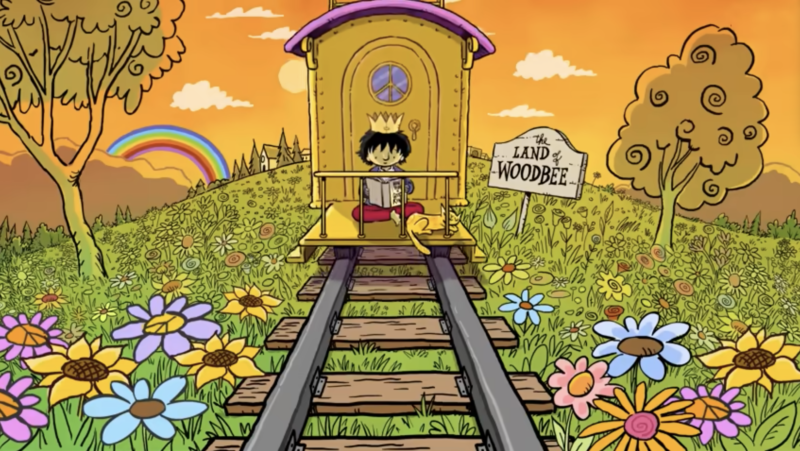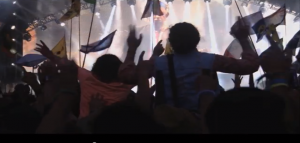Cat Stevens: King of a Land

If I was a king of a land
I’d free every woman and man
I’d let them go
I’d set them free to serve You
If I knew every fish in the sea
And every bird in the tree
I’d hear their call
I’d hear them speak Your name
If I ran the schools of this world
I’d teach every boy and girl
I’d let them learn the truth
I’d let them know Your glory
If I had the stairs to the sky
(If I had the stairs to the sky)
I’d raise my voice up there high
(Raise my voice up thеre high)
I’d want the world to hear
Your pеrfect words and thank You
If I had a mountain of gold
I’d try to feed every poor soul
And give them hope again
And let them taste Your bounty
If I could reach every dream
I still would search the unseen
To find a way
That leads us to Your mercy
If I was a king of a land
(If I was a king of a land)
I’d free every woman and man
(Free every woman and man)
I’d let them go
I’d set them free to serve You
This post is being published on Saturday 6th May 2023… the day the Coronation of King Charles III and Queen Camilla is taking place at Westminster Abbey in London.
Wouldn’t it be great if Cat Steven’s lyrics were echoed by the actions of the kings and queens of the world?
Thanks Cat — you’ve always been a favourite and an inspiration!
Read MoreSting: Rediscovering the Muse as The Last Ship Sails
constructed on the planet were built
right at the end of my street.”
— STING —
Sting grew up in the shadow of the shipyard, with giant ships rising into the air at the end of his street. Newcastle-Upon-Tyne was at the heart of the British shipbuilding industry.
The Dream
But instead of wanting to follow in the footsteps of generations of Tynesiders whose lives were inextricably linked with the docks and the shipbuilding industry, Sting had a different dream. It was one that grew exponentially with the discovery of a guitar in the attic at the age of 8 . “I was bequeathed a guitar and realised I had found a friend for life.”
The dream would become his life and Gordon Sumner would become internationally known as the musician Sting, but first he had to turn his back on his roots and travel away. He had no desire to return to the traumatised society he witnessed during the closure of the ship building industry.
It’s my belief that abstract economic theory that denies the needs of community or denies the contribution that community makes to economy is shortsighted, cruel and untenable”
— STING —
The muse Sting chose to follow as a singer/songwriter and multi-instrumentalist was one that would bring us such unforgettable songs as “Roxanne”, “Fields of Gold”, “Message in a bottle”, “Every Breath You Take” and “Englishman in New York”.
Sting’s astonishing success both as a member of “The Police” and during his solo career, together with his prolific song-writing ability made it particularly difficult for him to come to terms with a long period of “writer’s block” which stretched into years of self-questioning.
He eventually acknowledged a need to return to his roots in Newcastle, a decision which was to reunite him with his muse and he has spent the past few years working on a theatrical production called “The Last Ship” – inspired by the demise of the shipbuilding industry in the North East.
Sting released the album “The Last Ship” in 2013 and the musical production launched its pre-Broadway tryout in Chicago last Wednesday with songwriters Paul Simon, James Taylor and Dennis DeYoung watching from the orchestra seats, according to the review by Chris Jones in the Chicago Tribune.
Political Activism
A sense of the injustices caused by corrupted power led Sting along the path of political activism, participating in many of the focal moments in which creative artists have joined forces to raise international awareness of major issues: Band Aid, Live Aid, Feed the World”, Live8 etc.
His long involvement with Amnesty International which began with his appearance at the “Secret Policemen’s Other Ball” in 1981 has inspired some of the songs he has written.
“Before that I did not know about Amnesty, I did not know about its work, I did not know about torture in the world” .
Sting’s song “They Dance Alone” threw a spotlight on the plight of the mothers, wives and daughters of “The Disappeared” (political opponents killed by the Pinochet regime) in Chile. These women, under constant threat from Pinochet’s infamous death squads, were afraid to voice their opinions publicly but would pin photos of their missing loved ones to their clothing and dance in public places in unspoken outrage.
Dendropsophus Stingi and The Rainforest Foundation
Sting, his wife Trudi and Raoni Metuktire, a Kayapó Indian leader in Brazil, founded the “Rainforest Foundation” to help save the rainforests and protect the rights of the indigenous people living in them. (In recognition of his “commitment and efforts to save the rain forest”, a species of Colombian tree frog, Dendropsophus stingi, was named after him.)
In addition to 16 Grammy Awards, a Golden Globe, an Emmy and several Oscar nominations. Sting has sold nearly 100 million records worldwide, was 62nd on Paste Magazine’s list of 100 Best Living Songwriters, 63rd on VH1’s “100 Greatest Artists of Rock” and 80th on A magazines “100 Greatest Musical Stars of the 20th Century”
Read MoreRolling Stones Headline at Glastonbury
home to Glastonbury Abbey, one of the most important abbeys in England.
It’s also a town which attracts thousands of people interested in New Age or Pagan beliefs largely because of the myths and legends related to Glastonbury Tor.
These include references to the Holy Grail, King Arthur and Joseph of Arimathea, with some Arthurian literature identifying it as the legendary Island of Avalon.
Glastonbury Festival of Contemporary Performing Arts
Internationally Glastonbury is best known as home to the most famous music festival in the world – The Glastonbury Festival of Contemporary Performing Arts which includes dance, comedy, theatre, circus, cabaret and other arts as well as contemporary music.
Festival organiser Michael Eavis is a local farmer who was inspired after seeing the open air Led Zeppelin concert at Bath Festival of Blues and Progressive Music, 1970 to host an open air festival on the the farm. 14 people invested everything they had to build the stage (many told them the idea would never catch on). The first festival was in 1970 – and the rest as they say, is history.
Rolling Stones Live at Glastonbury 2013
The Rolling Stones headlined the Pyramid Stage, playing to a crowd of over 170,000 (not bad for a group that has been around for 50 years).
Their gig started around 9.45 pm at the end of a beautifully sunny day in Somerset with the crowd waiting in electric anticipation for the most high profile act ever to perform at Glastonbury (having taken 43 years to get there) .
The Stones played a twenty song set including a version of “Factory Girl” which with specially adapted lyrics became “Glastonbury Girl”
“It was one of the greatest rock and roll sets I’ve ever seen in my life and I think one of the greatest rock and roll sets Glastonbury has ever seen”. “They really just rocked it. The band seemed almost as impressed as the crowd. I guess the audience makes the gig as much as the band.” Telegraph music critic Neil McCormick
Rolling Stones Glastonbury Song List:
‘Jumpin’ Jack Flash’
‘It’s Only Rock ‘N Roll (But I Like It)’
‘Paint It, Black’
‘Gimme Shelter’
‘Glastonbury Girl’
‘Wild Horses’
‘Doom And Gloom’
‘Can’t You Hear Me Knocking’
‘Honky Tonk Women’
‘You Got The Silver’ ‘Happy’
‘Miss You’
‘Midnight Rambler’
‘2000 Light Years From Home’
‘Sympathy For The Devil’
‘Start Me Up’
‘Tumbling Dice’
‘Brown Sugar’
‘You Can’t Always Get What You Want’ ‘
(I Can’t Get No) Satisfaction’
What the Posters Say
An interesting article by musician and writer, Anya Pearson looks at festivals as an annual yardstick of Britain’s musical talent. By taking the much publicised Festival Posters and editing out all acts represented on the posters that do not include at least one female musician, she turns them into a barometer of gender equality in 21st Century Britain. “As a female musician currently in two mixed-gender bands, I have always been painfully aware of my minority status in the music scene.” she says.
Glastonbury 2013 Poster showing music acts appearing at the festival

Glastonbury 2013 Poster – showing only acts that include
at least one female musician (34%).

Glastonbury was not the worst offender for failing to represent female musicians, probably thanks partly to co-organiser of the event, Emily Eavis, but its poster still only had 34% of the acts that included female musicians.
Bestival 2013 Poster showing music acts appearing at the festival

Bestival 2013 Poster showing only acts that include
at least one female (21%)

Reading and Leeds 2013: Poster showing music acts appearing at the festivals

Reading and Leeds 2013: Poster showing only music acts appearing at
the festivals which include at least one female (17%)

Pearson concludes:
“Still, festivals alone are not to blame: promoters, managers and record labels all play their part. As a society we are less encouraging of girls who aspire to headline Glastonbury. I was lucky. My mother is a musician who started out in the 70s and always told me my XX chromosome was no barrier to making music.
That said, there are lots of brilliant female musicians out there – as Yoko Ono’s Meltdown at the Southbank Centre proved. Women aren’t passive consumers of popular culture – we just often lack a creative platform to showcase what we can do.”
http://www.glastonburyfestivals.co.uk/
http://womensliberationmusicarchive.co.uk/
http://www.southbankcentre.co.uk/whatson/festivals-series/yoko-onos-meltdown/
http://www.guardian.co.uk/commentisfree/2013/jun/26/glastonbury-festival-few-women-artists
Read MoreTrue Colours: The British Paraorchestra
Today at Buckingham Palace during the Queen’s Christmas Day Message the National Anthem was performed by the British Paraorchestra. They have become a well respected and familiar part of British music, but before the 2012 Paralympics very few people had even heard of them.
In the 2011 TED Talks video below, Conductor Charles Hazlewood speaks about the inspiration behind the orchestra, and introduces them as they make their first ever public performance.
Hazelwood talks of the universal power of music to communicate across language and cultural barriers, and asks why our musical culture excluded women from its major platforms until the 1960s, and why it still excludes disabled musicians today.
Where, he asks is their voice in society and why have they been rendered invisible.
It was in order to break this culture of exclusivity that Hazelwood formed the British Paraorchestra, the world’s first ensemble of professional disabled musicians. The quality of their music has inspired tens of thousands in Britain and beyond since they stepped into the international limelight with their performance during the closing ceremony of the 2012 Paralympic Games.
Even at their very first public performance, Hazelwood throws down the gauntlet to other countries saying: “Here’s our Paraorchestra, where’s yours?”
True Colours
The solo voice heard at the beginning and end of the track belongs to Lyn Levett, from the Paraorchestra. Lyn has cerebral palsy and cannot speak. With state-of-the-art technology she sings through her computer in True Colors, for the very first time.
- to enable The Kaos Signing Choir for Deaf & Hearing Children set up a new Saturday Signing Choir and
- to fund their next signed song DVD, and
- for the future growth and development of The British Paraorchestra.
Non-Profit Organisation:
Support the British Paraorchestra
“The British Paraorchestra is a non-profit organisation. We survive through donation and support from a variety of people and institutions. If you’d like to support us through donation please use the Paypal process on our website it’s secure, guaranteed and easy.
Most of our funding goes into facilitating travel and accommodation for our players, many of whom are dependent on full time personal assistants and travel with wheelchairs and other special equipment. As you can imagine that’s often a major challenge of logistics and accessibility.
We’re working hard to make every penny count and always welcome enquiries from people who want to help. Do contact us if you would like to talk about structural, corporate or institutional donations.
You can donate online, by cheque, bank transfer, credit or debit card and by post. Do get in touch if you need any other way of making a donation. Please make cheques out to British Paraorchestra, contact us for postal address.”





